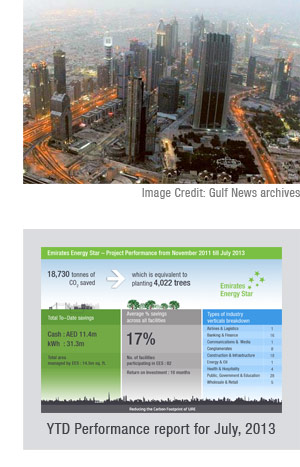
Press Releases
Energy initiative builds up scale across nation
More than 80 buildings covered as alliance eyes saturation coverage by end 2014

Dubai: The sustainability footprint is getting bigger — and going wide — in the UAE. The alliance between Pacific Controls and Etisalat, to bring about increased energy savings at older buildings under the Emirates Energy Star initiative, has found enough traction in Dubai and Abu Dhabi and plans to repeat the process across the country.
The aim is to reduce the carbon footprint at buildings under the programme’s purview in the UAE by 20 per cent within an optimum period.
The hard yards have already been run with more than 80 buildings, of which 53 are in Dubai, covered since the launch last year. The task ahead can seem just as daunting, though a top official at Pacific Controls was having none of that.
“It is our objective to penetrate each and every emirate (currently Emirates Energy Star is connected to buildings across six out of the seven emirates) and to scale up to several thousand buildings before the end of 2014,” said Sougata Nandi, CEO. “There is a clear mandate to engage thousands of buildings into this programme in the quickest possible time.”
A sentiment shared by Etisalat’s Abdullah Hashim – “our focus has always been across the entire country. In coming weeks we foresee more buildings from across all the emirates signing up as we continue to deliver on our current projects successfully.”
So, what does the initiative actually do? Older buildings represent the primary target since these are the ones less likely to feature optimum energy saving mechanisms.
Since these buildings would have an Etisalat network, the alliance partners can use this as the platform to put in place processes that would reduce consumption patterns, particularly on the air-conditioning side of things. (Not surprisingly, air-conditioning usage leads to the bulk of energy consumption in the UAE. Any property with preferably a centralised air conditioning system, can easily engage with the programme.)

Pacific Controls’ role is to deploy its ICT-based M2M (machine-to-machine) technology. “To exponentially scale this programme, increasing numbers of buildings are being brought under its ambit, by which it is expected that the carbon footprint of the UAE will be reduced much faster,” said Nandi. Of the initial buildings brought under the network, average savings attained has been pegged at 19 per cent plus, with an average return on investments (for the building’s owner) of seven months.
Apart from direct savings, additional ones come from “reduced maintenance costs due to shortened run time of equipment,” Nandi said. “With over 80 buildings now connected, the programme has a database of energy consumption profiles across different types of buildings.
“This is being utilised to benchmark multiple buildings across the same category, as well as different buildings belonging to the same owner. With benchmarking, stakeholders are able to understand the energy efficiency performance of their buildings better, particularly in comparison to each other and take educated decisions for their future projects in relation to the system design.
“Thus, the scope goes much beyond simple reduction of energy consumption to providing much needed data that enables intelligent system design process for future buildings.”
But what about buildings that do not feature centralised air-conditioning? “There is no technological limitation to connecting to a building’s air-conditioning system as there are multiple methodologies to achieve this,” said Nandi. “However, in the case of older equipment, the level and depth of communication that can be achieved is sometimes limited by the technology of the equipment itself.
“Wherever such limitations exist, alternative methodologies for connectivity are used, which may have an impact on the extent of the energy savings achieved. Notwithstanding the age, energy savings can be achieved in all types of buildings, except in situations where individual tenants are paying for their electricity consumptions inside their occupied space and thus the building has multiple users paying for their electricity bills separately.”
Gulf News
United Arab Emirates
